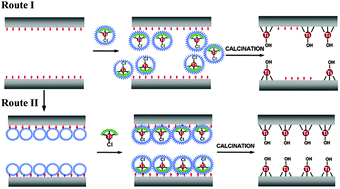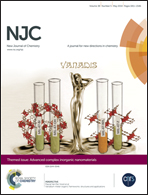Preparation and characterization of Ti supported bimodal mesoporous catalysts using a self-assembly route combined with a ship-in-a-bottle method†
Abstract
Ti/BMM (bimodal mesoporous silica) catalysts have been prepared via a self-assembly route combined with a ship-in-a-bottle technique. Four different methods were carried out to investigate the effects of adding ionic liquid [spmim][Cl−] (1-methyl-3-(3-trimethoxysilane) propylimidazole chloride) and triethanolamine (TEAOH) or triethylamine (TEA) to the coordination environment of the titanium species in the mesopores. The structural characteristics and textural properties of resultant samples were characterized by XRD, FT-IR spectroscopy, N2 adsorption–desorption isotherms, TGA, and UV-Vis spectroscopy. The results showed that the bimodal mesoporous structure of Ti/BMMs could be preserved after grafting Ti species via four preparation methods. On the other hand, the presence of [spmim][Cl−] and TEAOH or TEA could not only prevent titanium species existing on the mesoporous surface from aggregating, but also promote loading of tetrahedrally-coordinated titanium species with a high dispersion. Finally, their catalytic activities in the epoxidation of cyclohexene preliminarily indicated that the influence of Ti loading methods on the conversion of cyclohexene was remarkable.

- This article is part of the themed collection: Advanced Complex Inorganic Nanomaterials

 Please wait while we load your content...
Please wait while we load your content...